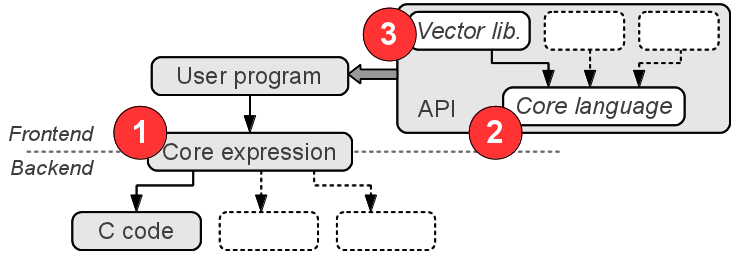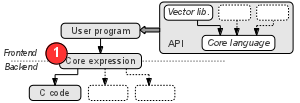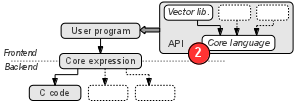Architecture

Emil Axelsson
AFP guest lecture, Feb 2012
Signal processing for mobile communication gets increasingly demanding
Old figures:
Industry needs to move to new, more parallel hardware architectures
Current signal processing code mostly written in C
A joint project with Ericsson, Chalmers and ELTE University (Budapest)
Aims to make digital signal processing (DSP) code more high-level
Method: Domain-specific language with associated compiler
Initial application: Radio base stations for mobile communication
Intension to be applicable for DSP in general
ANSI-C specification:
for (j = 0; j < L_frame; j++, p++, p1++)
{
t0 = L_mac (t0, *p, *p1);
}
corr[i] = t0;Equivalent loop optimized for specific processor:
#pragma MUST_ITERATE(80,160,80);
for (j = 0; j < L_frame; j++)
{
pj_pj = _pack2 (p[j], p[j]);
p0_p1 = _mem4_const(&p0[j+0]);
prod0_prod1 = _smpy2 (pj_pj, p0_p1);
t0 = _sadd (t0, _hi (prod0_prod1));
t1 = _sadd (t1, _lo (prod0_prod1));
p2_p3 = _mem4_const(&p0[j+2]);
prod0_prod1 = _smpy2 (pj_pj, p2_p3);
t2 = _sadd (t2, _hi (prod0_prod1));
t3 = _sadd (t3, _lo (prod0_prod1));
p4_p5 = _mem4_const(&p0[j+4]);
prod0_prod1 = _smpy2 (pj_pj, p4_p5);
t4 = _sadd (t4, _hi (prod0_prod1));
t5 = _sadd (t5, _lo (prod0_prod1));
p6_p7 = _mem4_const(&p0[j+6]);
prod0_prod1 = _smpy2 (pj_pj, p6_p7);
t6 = _sadd (t6, _hi (prod0_prod1));
t7 = _sadd (t7, _lo (prod0_prod1));
}
corr[i] = t0; corr[i+1] = t1;
corr[i+2] = t2; corr[i+3] = t3;
corr[i+4] = t4; corr[i+5] = t5;
corr[i+6] = t6; corr[i+7] = t7;Hand-optimized version probably not suited for a different processor; non-portable!
#pragma MUST_ITERATE(80,160,80);
for (j = 0; j < L_frame; j++)
{
pj_pj = _pack2 (p[j], p[j]);
p0_p1 = _mem4_const(&p0[j+0]);
prod0_prod1 = _smpy2 (pj_pj, p0_p1);
t0 = _sadd (t0, _hi (prod0_prod1));
t1 = _sadd (t1, _lo (prod0_prod1));
p2_p3 = _mem4_const(&p0[j+2]);
prod0_prod1 = _smpy2 (pj_pj, p2_p3);
t2 = _sadd (t2, _hi (prod0_prod1));
t3 = _sadd (t3, _lo (prod0_prod1));
p4_p5 = _mem4_const(&p0[j+4]);
prod0_prod1 = _smpy2 (pj_pj, p4_p5);
t4 = _sadd (t4, _hi (prod0_prod1));
t5 = _sadd (t5, _lo (prod0_prod1));
p6_p7 = _mem4_const(&p0[j+6]);
prod0_prod1 = _smpy2 (pj_pj, p6_p7);
t6 = _sadd (t6, _hi (prod0_prod1));
t7 = _sadd (t7, _lo (prod0_prod1));
}
corr[i] = t0; corr[i+1] = t1;
corr[i+2] = t2; corr[i+3] = t3;
corr[i+4] = t4; corr[i+5] = t5;
corr[i+6] = t6; corr[i+7] = t7;(Old) Idea: Automatically generate optimized code from high-level algoritm
Code generator:
High-level language more readable and maintainable
Flexible code generator makes code portable
Platform-specific optimizations still needed, but should ideally be specified separately from algorithm
Implementing a domain-specific language (DSL) from scratch is costly
Embedded DSL (EDSL) [Hudak1998, Elliott2003]:
Language front-end:
Back-ends:
Sum of squares: $\sum_{i=1}^{n} i^{2}$
File header:
import qualified Prelude as P
import Feldspar -- Core language
import Feldspar.Vector -- List-like data structure
import Feldspar.Compiler -- C code generatorFeldspar code:
square x = x*x
sumSq :: Data Index -> Data Index
sumSq n = sum $ map square (1...n)Compare to standard Haskell:
sumSqHaskell :: Int -> Int
sumSqHaskell n = P.sum $ P.map square [1..n]Generated C code:
*Main> icompile sumSq
...
void test(struct array * mem, uint32_t v0, uint32_t * out)
{
uint32_t v2;
(* out) = 0;
for(uint32_t v1 = 0; v1 < v0; v1 += 1)
{
uint32_t v3;
v3 = (v1 + 1);
v2 = ((* out) + (v3 * v3));
(* out) = v2;
}
}Standard list operations:
length :: Vector a -> Data Length
sum :: Numeric a => Vector (Data a) -> Data a
map :: (a -> b) -> Vector a -> Vector b
zipWith :: (Syntax b, Syntax a) =>
(a -> b -> c) -> Vector a -> Vector b -> Vector c
...Enumeration:
(...) :: Data Index -> Data Index -> Vector (Data Index)Construction from a projection function:
indexed :: Data Length -> (Data Index -> a) -> Vector aEtc…
Scalar product: $\sum_{i=0}^{N-1} a_i \cdot b_i$
scProd :: Numeric a => Vector1 a -> Vector1 a -> Data a
scProd a b = sum $ indexed n $ \i -> a!i * b!i
where
n = length a `min` length bMore “functional”:
scProd2 :: Numeric a => Vector1 a -> Vector1 a -> Data a
scProd2 a b = sum $ zipWith (*) a bIdentical C code (see demo)!
sum, indexed and zipWith are meta-constructs implemented “on top of” FeldsparQuickCheck:
prop_scProd :: Vector1 Float -> Vector1 Float -> Data Bool
prop_scProd a b = scProd a b == scProd2 a b*Main> quickCheck prop_scProd
+++ OK, passed 100 tests.



Feldspar uses a special representation of the AST (see part III)
However, the representation is isomorphic to a recursive data type:
data Data a
where
Literal :: (...) => a -> Data a
Add :: (Num a, ...) => Data a -> Data a -> Data a
Sub :: (Num a, ...) => Data a -> Data a -> Data a
ForLoop :: (...)
=> Data Length
-> (Data Index -> Data st -> Data st)
-> Data st
...ForLoop)
A large number of primitive functions, e.g:
not :: Data Bool -> Data Bool
(&&) :: Data Bool -> Data Bool -> Data Bool
(||) :: Data Bool -> Data Bool -> Data Bool
div :: (Size a ~ Range a, Integral a) => Data a -> Data a -> Data a
mod :: (Size a ~ Range a, Integral a) => Data a -> Data a -> Data a
instance Numeric a => Num (Data a)
...Prelude functions
Complex constructs:
forLoop :: Type st
=> Data Length -- Number of steps
-> Data st -- Initial state
-> (Data Index -> Data st -> Data st) -- "Body" (single step)
-> Data st -- Final state
parallel :: Type a
=> Data Length -- Length of result
-> (Data Index -> Data a) -- Index projection
-> Data [a] -- Core language arrayAnd much more…
Core language version of sumSq:
sumSq2 :: Data Index -> Data Index
sumSq2 n = forLoop (n+1) 0 $ \i s -> s + i*i*Main> eval sumSq2 10
385
*Main> eval sumSq 10
385
The first n powers of 2:
powsOf2 :: Data Index -> Data [Index]
powsOf2 n = parallel n (2^)*Main> eval powsOf2 10
[1,2,4,8,16,32,64,128,256,512]

The Syntax class abstracts over Data:
class Syntax a
where
type Internal a
desugar :: a -> Data (Internal a)
sugar :: Data (Internal a) -> a
instance Type a => Syntax (Data a)
where
type Internal (Data a) = a
desugar = id
sugar = id
Vectors are syntactic sugar:
instance Syntax a => Syntax (Vector a)
where
type Internal (Vector a) = [Internal a]
...Tuples are also sugar, etc.

Type of vectors:
data Vector a
where
Indexed :: Data Length -> (Data Index -> a) -> Vector a
indexed :: Data Length -> (Data Index -> a) -> Vector a
indexed = Indexed
type Vector1 a = Vector (Data a)
type Vector2 a = Vector (Vector (Data a))(The Vector type provided by Feldspar is slightly more complicated.)
A vector is not a core expression, but it can be turned into one:
length :: Vector a -> Data Length
length (Indexed l _) = l
index :: Vector a -> Data Index -> a
index (Indexed _ ixf) i = ixf i
freeze :: Type a => Vector (Data a) -> Data [a]
freeze (Indexed len ixf) = parallel len ixf
fold :: Syntax a => (a -> b -> a) -> a -> Vector b -> a
fold f init b = forLoop (length b) init $
\i st -> f st (index b i)a and b are either core expressions or some other high-level type that can be turned into a core expression.See demo

Features:
http://hackage.haskell.org/package/syntacticdata AST dom a
where
Symbol :: ConsType a => dom a -> AST dom a
(:$:) :: Typeable a => AST dom (a :-> b)
-> AST dom (Full a)
-> AST dom b
type ASTF dom a = AST dom (Full a)Helper definitions:
newtype Full a = Full { result :: a }
newtype a :-> b = Partial (a -> b)
infixr :->
class ConsType a
instance ConsType (Full a)
instance ConsType b => ConsType (a :-> b)
infixl 1 :$:Standard expression GADT:
data Expr1 a
where
Lit1 :: Num a => a -> Expr1 a
Add1 :: Num a => Expr1 a -> Expr1 a -> Expr1 a
lit1 :: Int -> Expr1 Int
lit1 x = Lit1 x
add1 :: Expr1 Int -> Expr1 Int -> Expr1 Int
add1 x y = Add1 x y
eval1 :: Expr1 Int -> Int
eval1 (Lit1 x) = x
eval1 (Add1 x y) = eval1 x + eval1 y*Main> eval1 (lit1 4 `add1` lit1 5)
9
Same expression type represented using AST:
data NumDomain2 a
where
Lit2 :: Num a => a -> NumDomain2 (Full a)
Add2 :: Num a => NumDomain2 (a :-> a :-> Full a)
type Expr2 a = ASTF NumDomain2 a
lit2 :: Int -> Expr2 Int
lit2 a = Symbol (Lit2 a)
add2 :: Expr2 Int -> Expr2 Int -> Expr2 Int
add2 x y = Symbol Add2 :$: x :$: y
eval2 :: Expr2 a -> a
eval2 (Symbol (Lit2 a)) = a
eval2 (Symbol Add2 :$: a :$: b) = eval2 a + eval2 bThe underlying representation does not affect the user interface:
*Main> eval1 (lit1 4 `add1` lit1 5)
9
*Main> eval2 (lit2 4 `add2` lit2 5)
9
AST?Reason 1: Generic traversals
countSyms :: AST dom a -> Int
countSyms (Symbol _) = 1
countSyms (f :$: a) = countSyms f + countSyms a*Main> countSyms (lit2 4 `add2` lit2 5)
3
ASTReason 1: Generic traversals
Use type classes to make generic traversals aware of certain symbols:
class HasAddition dom
where
isAdd :: dom a -> Bool
instance HasAddition NumDomain2
where
isAdd Add2 = True
isAdd _ = False
countAdd :: HasAddition dom => AST dom a -> Int
countAdd (Symbol a) | isAdd a = 1
countAdd (Symbol _) = 0
countAdd (f :$: a) = countAdd f + countAdd aASTReason 2: Extensible symbol domains
Higher-kinded version of the Either type constructor:
data dom1 :+: dom2 :: * -> *
where
InjectL :: dom1 a -> (dom1 :+: dom2) a
InjectR :: dom2 a -> (dom1 :+: dom2) a
infixr :+:ASTReason 2: Extensible symbol domains
Splitting the domain:
data Lit3 a where Lit3 :: Int -> Lit3 (Full Int)
data Add3 a where Add3 :: Add3 (Int :-> Int :-> Full Int)
type NumDomain3 = Lit3 :+: Add3
type Expr3 a = ASTF NumDomain3 a
lit3 :: Int -> ASTF NumDomain3 Int
lit3 a = Symbol (InjectL (Lit3 a))
add3 :: ASTF NumDomain3 Int
-> ASTF NumDomain3 Int
-> ASTF NumDomain3 Int
add3 x y = Symbol (InjectR Add3) :$: x :$: yASTReason 2: Extensible symbol domains
Use type classes to make the domain abstract:
lit3 :: (Lit3 :<: dom) => Int -> ASTF dom Int
add3 :: (Add3 :<: dom) =>
ASTF dom Int -> ASTF dom Int -> ASTF dom Int
countAdd :: (Add3 :<: dom) => AST dom a -> Int
eval :: Eval dom => AST dom a -> a(:<:), Eval and many other type classes dealing with abstract domainsparallelparallelAbstract syntax symbol:
data Array a
where
Parallel :: Type a => Array
( Length -- Number of elements
:-> (Index -> a) -- Index projection
:-> Full [a] -- Result
)
-- Other array constructs omittedparallelAbstract syntax symbol:
data Array a
where
Parallel :: Type a => Array
( Length -- Number of elements
:-> (Index -> a) -- Index projection
:-> Full [a] -- Result
)
-- Other array constructs omittedUser interface (using type-class magic from Syntactic):
parallel :: Type a =>
Data Length -> (Data Index -> Data a) -> Data [a]
parallel = sugarSym ParallelparallelSemantics:
instance IsSymbol Array where
toSym Parallel = Sym
"parallel"
(\len ixf -> genericTake len $ map ixf [0..])parallelSemantics:
instance IsSymbol Array where
toSym Parallel = Sym
"parallel"
(\len ixf -> genericTake len $ map ixf [0..])Additionally:
parallelSummary: declarative implementation of parallel in ≈ 40 LOC
parallelSummary: declarative implementation of parallel in ≈ 40 LOC
What do we get?
parallelSummary: declarative implementation of parallel in ≈ 40 LOC
What do we get?
Feldspar expression type:
newtype Data a = Data { unData :: AST FeldDomainAll (Full a) }Feldspar expression type:
newtype Data a = Data { unData :: AST FeldDomainAll (Full a) }The symbol domain:
type FeldDomainAll = HODomain TypeCtx FeldDomain
type FeldDomain
=
-- Generic constructs (from Syntactic):
Decor SourceInfo1 (Identity TypeCtx)
:+: Condition TypeCtx
:+: Let TypeCtx TypeCtx
:+: Literal TypeCtx
:+: Select TypeCtx
:+: Tuple TypeCtx
-- Feldspar-specific constructs:
:+: Array
:+: BITS
:+: COMPLEX
:+: Conversion
:+: EQ
:+: Error
:+: FLOATING
:+: FRACTIONAL
:+: INTEGRAL
:+: Logic
:+: Loop
:+: LoopM Mut
:+: MONAD Mut
:+: Mutable
:+: MutableArray
:+: MutableReference
:+: NUM
:+: ORD
:+: PropSize
:+: Trace
:+: MutableToPure
:+: ConditionM Muttype FeldDomain
=
...
:+: Array
:+: BITS
:+: COMPLEX
:+: Conversion
:+: EQ
...The different “features” (e.g. Array) are developed independently and assembled “in the last minute”
Feldspar (upcoming version 0.5 is based on Syntactic):
http://hackage.haskell.org/package/feldspar-language
http://hackage.haskell.org/package/feldspar-compiler
Syntactic:
http://hackage.haskell.org/package/syntactic
> cabal unpack syntactic
Downloading syntactic-0.7...
Unpacking to syntactic-0.7/
> cd syntactic-0.7/Examples/NanoFeldspar/
The Resource-AWare Functional Programming project (RAWFP) invites to a Feldspar hacking session
Feldspar-related masters theses
Hudak. Modular Domain Specific Languages and Tools.
In ICSR ’98: Proceedings of the 5th International Conference on Software Reuse. 1998. IEEE Computer Society.
Elliott, Finne, de Moor. Compiling Embedded Languages.
Journal of Functional Programming. 2003. Cambridge University Press.